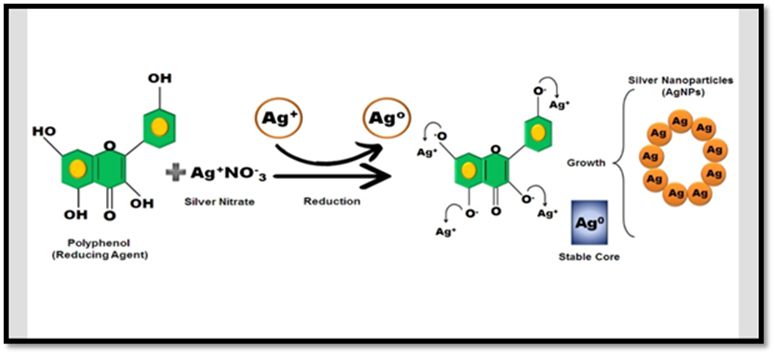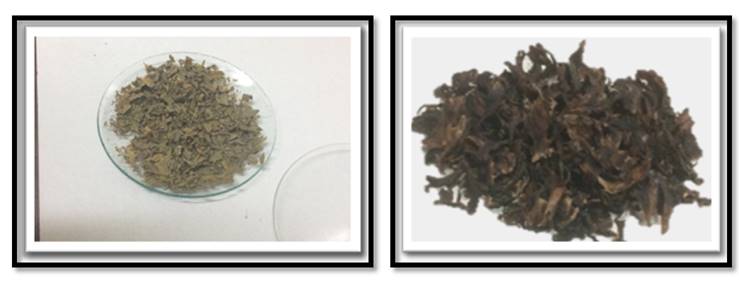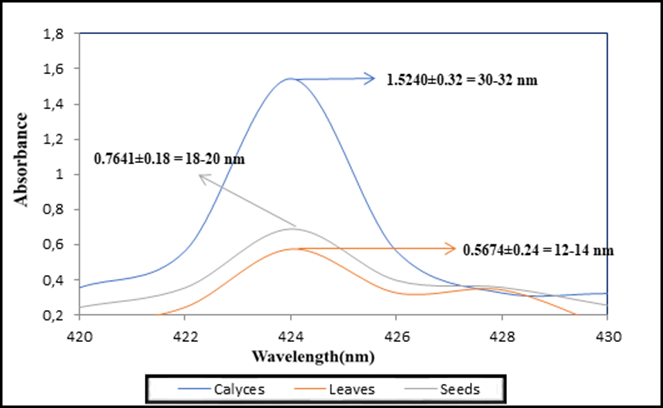INTRODUCTION
Silver nanoparticles (AgNPs) have been one of the most attractive nanomaterials in biomedicine due to their unique physicochemical properties 1. Other biological activities of AgNPs have been also explored, including promoting bone healing and wound repair, enhancing the immunogenicity of vaccines, and anti-diabetic effects 2,3,4. Globally, research focus on the synthesis of AgNPs with controlled size and shape, and a variety of specific synthetic methods have been developed, including, chemical, physical and biological methods 5,6 (Figure 1).
The synthesis of AgNPs due to biological processes aims to change the reagents used in chemical synthesis with another type of substances that can perform the same role. The "green synthesis" of silver nanoparticles, in which plant extracts are used, has gained great interest in recent years. This type of synthesis is efficient both in terms of reaction time, as well as stability of nanoparticles that exclude toxic chemical agents 7. In this sense Hibiscus sabdariffa, an easy-access and high-content plant in phenolic compounds, is an alternative as a bilingual material for AgNPs synthesis 8,9. Considering then the importance of AgNPs and their impact on biomedical sciences, the study aimed to synthesize and estimate the size of AgNPs, using aqueous extracts of calyxes, leaves and seeds of H. sabdariffa obtained from an organic culture, thus promoting the "Green Synthesis".
EXPERIMENTAL
Origin of plant material (PM)
The calyces, leaves and seeds were obtained from an organic culture. The harvest was carried out on the researcher's own lands located in the Coropo sector, Aragua state, Venezuela (October 2019-March 2020).
Sample preparation for extraction
For extracts 2,5 grams of plant material were weighed. This was poured into a 400 mL Beaker, to which 200 mL of distilled water previously heated to the boiling point was added. The sample was slightly stirred for 4 min and filtered using Whatman No. 4 paper 10.
Determination of total phenolics
For the determination of total phenolics, 50 μL were mixed with 250 μL of the Folin-Ciocalteu 1 N reagent (Analytical grade, Merck). It was left to stand for 8 minutes and then 750 µL of 20% Na2CO3 and 950 µL of distilled water were added. Was incubated for 30 min at room temperature and the absorbance was read on a Genesis 20 UV/VIS spectrophotometer (Thermo Scientific, Waltham, Massachusetts, USA). A calibration curve for Gallic Acid (Sigma-Aldrich, Germany) was prepared with concentrations of 50, 100, 200, 300, 400, 500 and 1000 ppm. The results were expressed in mg of Gallic Acid Equivalents (GAE) /g of PM 11.
Determination of flavonoids
A volume of 100 μL of sample was mixed with 30 μL of 5% w/v NaNO2, 30 μL of 10% w/v AlCl3, 200 μL of 1 M NaOH and adjusted with distilled water to a final volume of 1 mL. The reading was performed at 510 nm in a Genesis 20 UV / VIS spectrophotometer and was compared with a standard curve with standard (+)-catechin (Sigma Aldrich, USA). The results were expressed in mg of Catechin Equivalents (CE) / g of PM 12.
Synthesis of AgNPs-UV-VIS spectrophotometry
Nanoparticle formation was analyzed by UV-VIS Spectrophotometry (Thermo Scientific, Waltham, Massachusetts, USA). A spectral scan of each synthesis was carried out, obtained with the extracts of the various parts of the plant, in a range of wavelengths from 420 to 430 nm, estimating the size of the nanoparticles from (2 to 40 nm). For the analysis of the nanoparticles, 2 ml of each synthesis were taken and diluted with distilled water to a final volume of 4 mL. 1 mL of the previous dilution was placed in a cell with 1 cm of optical path and the spectral scan was carried out 13,14.
Optimisation of the synthesis of silver nanoparticles and Statistical analysis
The parameters to be optimised were: concentration of silver nitrate, volume of extract, pH, heating time and temperature. The StatGraphics programme was used with a screening design class. All determinations (phenolic compounds, flavonoids) and the spectral sweep corresponding to each synthesis were performed in quintuplicate and values were expressed as mean ± standard deviation. Statistical differences were determined by analysis of variance (ANOVA) using Statistic 9.0 for Windows.
RESULTS AND DISCUSSION
Total phenolics and flavonoids of the extracts
Prior to the synthesis and estimation of the size of the AgNPs, the concentration of total phenolics was determined in quintuplicate, obtaining a concentration of 17.42± 0.12 mg GAE / g PM (calyces), 9.03 ± 0.91 mg GAE/g PM (leaves) and 11.32±0.36 mg GAE/g PM (seeds), observing a statistical difference (p=0.035). For flavonoids it was of 12.17 ± 0.22 mg CE/g PM (calyces), 6.45 ± 0.67 mg CE/g PM (leaves) and 9.32 ± 0.28 mg CE/g PM (seeds) (p=0.045). The difference observed is similar to that reported in several studies carried out with Hibiscus sabdariffa, which indicate that the concentration of phenolic compounds and flavonoids it varies in the different parts of the plant, also conditioned by various factors (plant genetics, climate, soil conditions, cultivation) 15,16,17.
Optimal conditions for the synthesis of AgNPs
As indicated above, the material used corresponds to an organic culture of H. sabdariffa. In this sense, when using different parts of the pant, the appropriate conditions for the synthesis of nanoparticles were apotimized 18,19,20 (Table 1).
Table 1 Optimal conditions for the synthesis of AgNPs
| Optimization | Calyces | Leaves | Seeds |
|---|---|---|---|
| *AgNO3 Solution (mL) | 2.7 | 3.5 | 2.8 |
| Time (min) | 4.3 | 5.5 | 4.7 |
| Temperature (°C) | 91 | 82 | 84 |
| Volume Extract (mL) +pH | 4.7 7.3 | 6.8 6.6 | 8.0 7.1 |
*Silver nitrate concentration: 1.2 mM (Calices), 0.98 mM (leaves), 1.25 mM (Seeds). +pH adjusted with sodium hydroxide.
UV-VIS spectroscopy is a very powerful tool to monitor the synthesis of the AgNPs as the metallic nanoparticles possess a property known as surface plasmon resonance which is primarily because of the oscillation of the free electrons present on the surface of the metallic nanoparticles when they are excited by any external energy source1.The three solutions yielded maximum absorption peaks at 424 nm, observing that the synthesis of AgNPs, using the calyces, originated the highest absorbance value (Figure 3). All this shows that the characteristic peak for the formation of silver nanoparticles is around 422-426 nm, where the size of silver nanoparticles is estimated to be between 2 and 40 nm. 18,19.
On the other hand, the morphology of the synthesized nanoparticles plays a fundamental role in its biological activity21,22,23,24. Although the morphology of the AgNPs was not characterized, what was found in the study represents an important contribution to the green synthesis, leaving pending further studies, not only the characterization of the AgNPs, but also their biological potential.
CONCLUSION
In conclusion, it must be said that the various parts of H. sabdariffa constitute an excellent alternative for the synthesis of silver nanoparticles, allowing to appreciate that its performance is conditioned to the presence of compounds with reducing capacity. Finally, this study provides interesting data for those researchers whose synthesis of nanoparticles is based on the "Green Synthesis".












 uBio
uBio 




